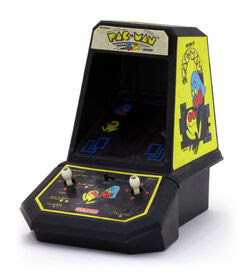Coleco’s Pac-Man Tabletop Game Brought the Arcade Experience Home

The eighties passion for Pac-Man led to the creation of this miniature arcade game version—part of a series.
by Rich Watson
In 1982, during the height of the Pac-Man craze, Coleco released a tabletop home version of the immensely popular arcade game.
I had one because I was as much into Pac-Man as everyone else at the time.
Pac-Man fever
In 1980, Namco released “Puck-Man,” an arcade game designed by Toru Iwatani. In North America, the name was changed to Pac-Man and released through Midway Manufacturing. (Here’s an interview with Iwatani from 2020.)
You know how the game works: maze, little yellow sprite gobbling dots, ghosts chasing him. It became Japan’s highest-grossing arcade game of 1980 and America’s highest-grossing arcade game of 1981. It led to the spin-offs Ms. Pac-Man, Super Pac-Man, Baby Pac-Man and more.
Pac-Man inspired a host of merchandise, some of it stranger than others. It inspired a novelty hit song, a Saturday morning cartoon, and many other cash-in products. A Pac-Man movie version is supposedly in the works, though it’ll be hard to top his appearance in Pixels.
I watched the cartoon every Saturday. I owned a book on how to win at Pac-Man (for all the good it did me), a Pac-Man board game, and of course, this week’s subject: the Pac-Man tabletop game.
Coleco’s Mini-Arcade
Coleco, a former supplier of leather and rubber footwear, switched to making toys in the fifties and to video games and game consoles in the seventies, particularly the handheld kind.
During the peak arcade game period of the early eighties, Coleco created a set of battery-operated, portable electronic video games meant to resemble arcade games.
The Mini-Arcade Tabletop Game series began with Pac-Man, Donkey Kong, Galaxian and Frogger and added Ms. Pac-Man, Donkey Kong Jr. and Zaxxon. Their vacuum fluorescent displays enabled the games to more closely resemble the original versions than the home game consoles like the Atari 2600.
The original four tabletops went on to sell over three million units by year’s end. Pac-Man alone sold 1.5 million. They were so popular they appeared in TV shows and movies.
Playing the Pac-Man tabletop
The Coleco Pac-Man tabletop could be played in three ways: the original arcade version, maze, dots, ghosts and all, a two-player head-to head version, and a version called “Eat and Run,” where the emphasis is on collecting the power pellets.
I stuck with the classic arcade version most of the time. As I recall, the sound effects were quite loud; I probably drove my parents nuts whenever I played it. The miniature joystick didn’t feel as fluid as the arcade version, but it worked, until it broke from overuse.
Because it was smaller, I felt more adept with this version than the original. I never did well at the arcade Pac-Man. I was better at Ms. Pac-Man, which had several different maze configurations (Pac-Man only had one). Also, the versions of Ms. Pac-Man I were often sped up slightly, which I found allowed for greater fluidity of movement. The versions of Pac-Man I played weren’t as fast.
Other Coleco successes
Coleco made other portable games, such as handheld versions of football and baseball, as well as a series of educational games. In 1982, the ColecoVision home console also came out. Then, a year later, came arguably Coleco’s biggest toy and game success: the Cabbage Patch Kids.
Subsequent products failed to catch on. By 1988 Coleco filed for bankruptcy and Hasbro purchased its remains.
The Mini-Arcade Tabletops can be found on eBay and in collectors’ markets. They’re still worth buying.
—————————
Did you play the Pac-Man tabletop game?

